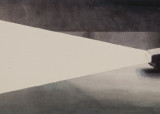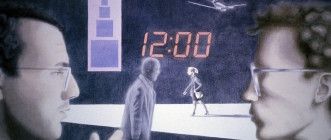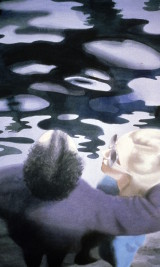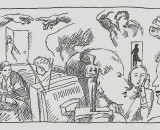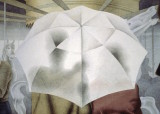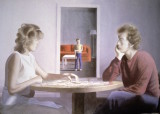Search for Ideas
Robert made strong and enduring friendships in art school. After graduation, his friends began to disperse and leave the province, giving Robert a bitter taste of “going down the road.” Robert associated this quest for outside opportunity with the idea of exile and expulsion. He first treated the theme in a half-serious and ironical way, with reference to a pop song, in Escape from the Promised Land. The theme became more serious in Escape and The Conversation, and led him to his first paintings in which two characters confront one another over a difficult choice.
To distract himself from the pain and disruption of his cancer treatments, Robert watched classic Hollywood films. Robert noted how these films, so full of style and glamour, action and romance, made a connection with viewers in a way that contemporary fine art was rarely able to match. Robert’s paintings began to mimic cinematic elements, using models posed in dramatic settings. Robert focused on relationships between people, developing his own blend of fantasy, allegory and realism in carefully planned pictures such as Shifting Weather and Harbour.
Surprisingly, it was the moody look and nightmarish elements of film noir that made the strongest impression on Robert’s art. In Fresh Widower, Robert portrays an anti-hero cut off from contact with others. Heart Attack explores a fatal irony. In later works, Robert applied the look and imagery of film noir in two unlikely settings: his series on lovers and his series on cancer.
Robert balanced his interest in pop culture with an equally strong interest in literature and art history. Prufrock and Underground Parking tackle the subject of death and afterlife.

